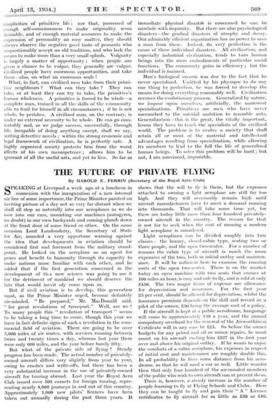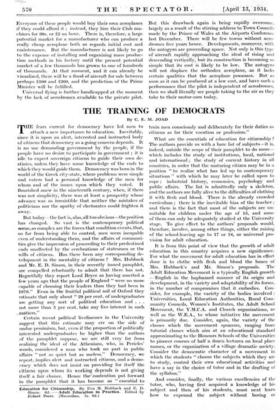THE FUTURE OF PRIVATE FLYING
By HAROLD E. PERRIN (Secretary of the Royal Aero Club)
SPEAKING at Liverpool a week ago at a luncheon in connexion with the inauguration of a new internal air line of some importance, the Prime Minister painted an inviting picture of a day not so very far distant when we shall all step . as naturally into our aeroplanes as we do now into our cars, mounting our machines (autogyros, no doubt) in our own backyards and coming plumb down at the front door of some friend or other. On the same occasion Lord Londonderry, the Secretary of State for Air, sounded a very opportune warning against the idea that developments in aviation should be considered first and foremost from the military stand- point. He looked on the aeroplane as an agent for peace and benefit to humanity through its capacity to make nations more familiar with each other, and he added that if the first generation concerned in the development of this new science was going to use it for the detriment of mankind we should deserve the fate that would inevit oly come upon us.
But if civil aviation is to develop, this generation must, as the Prime Minister urged, become definitely air-minded. "Be prepared," Mr. MacDonald said, "for great revolutions of transport." Well, are we ? To many people this "revolution Of transport" seems to be taking a long time to come, though this year we have in fact definite signs of such a revolution in the com- mercial field of aviation. There are going to be over 5,000 .miles of air routes, with services running between twice and twenty times a day, whereas last year there were only 600 miles, and the year before barely fifty.
But what. of the private side .of flying Steady progress has been made.' The actual number of privately- owned aircraft' differs very 'slightly from year to year, owing -to crashes and write-offs, but there has been a very substantial increase in the use of privately-owned aircraft for touring abroad. Last year the Royal Aero Club issued over 500 carnets for foreign touring, repre- senting nearly 8,000 journeys in and out of this country. Approximately 1,000 new pilots' licences have been taken out annually during the past three years. It shows that the will to fly is there, but the expenses attached to owning a light aeroplane are still far too high. And they will necessarily remain high until aircraft manufacturers have to meet a demand running into thousands. That will take some time yet, for there are today little more than four hundred privately- owned aircraft in the country. The reason for that is not far to seek when the cost of running a modern light aeroplane is considered.
Light aeroplanes can be divided, roughly into two classes : the luxury, closed-cabin type, seating two or three people, and the open two-seater. For a number of reasons the cabin type of aircraft is much the more expensive of the two, both in initial outlay and mainten- ance. It will be sufficient here to examine the running costs of the open two-seater. There is on the market today an open, machine with two seats that cruises at 100 miles an hour, is easy and safe to fly, and is sold at only £450. The two major items of expense arc allowance for depreciation and insurance. For the first year 25 per cent, should be allowed for depreciation, whilst the insurance premium depends on the skill and record as a pilot of the owner, £50 being. the average cost of a policy. If the aircraft is kept at a public aerodrome, hangarage *ill come to approximately £40 a year, and the annual compulsory overhaul for the renewal of the Airworthiness Certificate will in any ease be £25. So before the owner budgets for any petrol and oil or minor repairs, he must count on his aircraft costing him £227 in the first year over and above his original outlay. If he wants to enjoy the comforts of a cabin aeroplane, his expenses in respect of initial cost and maintenance are roughly double this. In all probability he lives some distance from his aero- drome, so that he will need a car as well. Little wonder then that only four hundred of the air-minded members of the public who wish to own aircraft can at present do so.
There is, however, a- steady increase in the number of people learning to fly at Flying Schools and Clubs. Here they can be taught to fly and gain their " A " Licence certificates to fly aircraft for as little as £30 or £40. Everyone of these people would buy their own aeroplanes if they could afford it ; instead, they hire their Club ma- chines for 30s. or /2 an hour. There is, therefore, a large Potential market for a manufacturer who can produce a really cheap aeroplane both as regards initial cost and maintenance. But the manufacturer is not likely to go to the expense of installing and organizing mass produc- tion methods in his factory until the present potential market of a few thousands has grown to one of hundreds of thousands. At that moment, and it can already be visualized, there will be a flood of aircraft for sale between perhaps /100 and 1200, and the prediction of the Prime Minister will be fulfilled.
Universal flying is further handicapped at the moment by the lack of aerodromes available to the private pilot. But this drawback again is being rapidly overcome, largely as a result of the stirring address to Town Councils made by the Prince of Wales at the Airports Conference last December. There will be few towns without aero- dromes five years hence. Developments, moreover, with the autogyro are proceeding apace. Not only is this type of aircraft rapidly approaching the ideal of rising and descending vertically, but its construction is becoming so simple that its cost is likely to be low. The autogyro will not displace the orthodox aeroplane, . as it lacks certain qualities that the _ aeroplane possesses. But as soon as it can be produced at a low cost, and have such a performance that the pilot is independent of aerodromes, then we shall literally see people taking to the air as they take to their motor-cars today.

















































 Previous page
Previous page